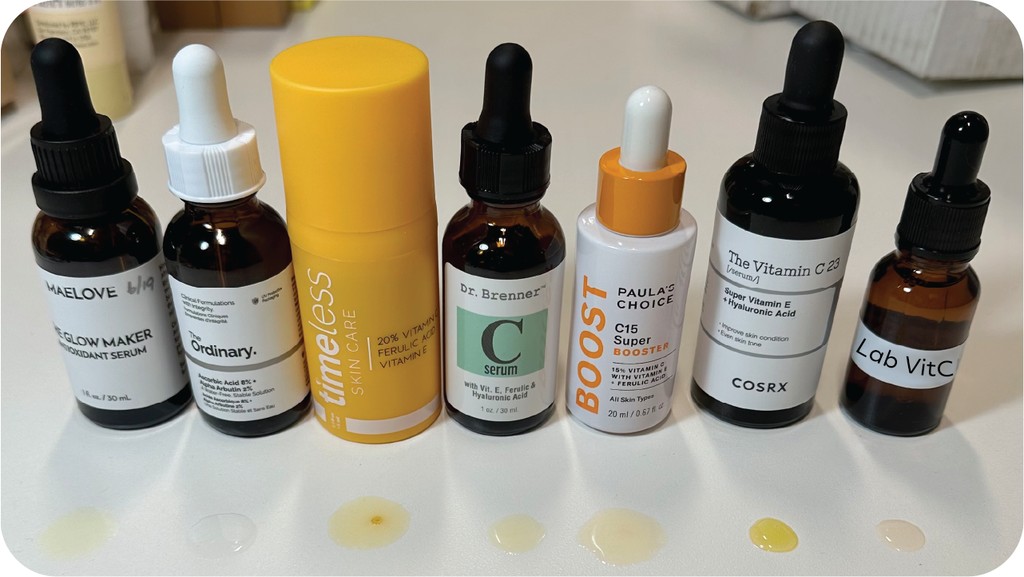Skinceuticals C E Ferulic serum has long been hailed as a gold standard in vitamin C serums, celebrated for its potent antioxidant cocktail and ability to combat aging signs. However, its high price point often leaves consumers searching for more affordable alternatives. This leads to a crucial question for skincare enthusiasts: is there an ordinary serum that can truly compare to the renowned Skinceuticals C E Ferulic? To investigate this, we conducted a stability test on several popular vitamin C serums, including both high-end and drugstore options, to see how they measure up.
Week 1: Initial Observations
At the start of our experiment, all the vitamin C serums were visually quite clear, which is typical for fresh formulations. Serums from Paula’s Choice and Timeless Skincare exhibited a very subtle tint, while Dr. Brenner and Maelove were nearly colorless. This initial color variation is considered normal for vitamin C serums. Upon opening, we noted a slight release of gas from the Paula’s Choice and CosRx bottles, suggesting some initial degassing. Interestingly, the CosRx serum already presented a more pronounced yellow tint compared to the others right from the beginning.
After one week, we observed a subtle yellowing across all serums, a common and expected change as vitamin C oxidizes slightly. The characteristic “hot dog water” scent, often associated with vitamin C serum degradation, became more noticeable. Timeless serum showed a peculiar darker globule, which we attributed to product buildup in the pump. Both Paula’s Choice and CosRx continued to show signs of gas buildup within their bottles. Notably, the CosRx dropper showed visible ballooning, a quicker reaction than anticipated, raising a potential early warning sign.
Week 2: Further Changes Emerge
Week two brought more distinct changes. While most serums maintained a similar color progression, Timeless serum showed a more significant color shift, indicating faster oxidation. CosRx was the only formula that exhibited further gas buildup and continued dropper ballooning. An unusual observation with the CosRx serum was its tendency to splatter and appear to separate slightly, suggesting a potential instability within the formula itself. This behavior was unique to CosRx and not seen in the other tested serums.
Week 3: End of Stability Test
By week three, the yellow to brown tints became more pronounced in most serums, signifying ongoing oxidation. CosRx continued to exhibit consistent gas buildup and dropper ballooning. More concerningly, the CosRx formula showed visible signs of separation, indicating a significant breakdown of the serum’s integrity. This separation is a strong indicator of instability and potential loss of efficacy.
Analyzing the Results: Which Serums Hold Up?
To determine which of these ordinary serums could be considered comparable to Skinceuticals C E Ferulic, we assessed their performance based on color change, packaging integrity, smell, and formula stability throughout our heat test.
Top Performers: Maelove Glow Maker, Dr. Brenner Vitamin C Serum, and Paula’s Choice C15 Super Booster
These three ascorbic acid serums demonstrated consistent and stable performance throughout the study. Their color progression, minimal packaging issues, and normal smell development were all within expected parameters for vitamin C serums. Based on our observations, these serums passed our stability test, suggesting they are reliable alternatives in terms of formulation integrity.
Timeless Skincare 20% Vitamin C + E Ferulic: Pass with Caveats
Despite showing slightly faster degradation and sputtering from the pump, Timeless Skincare’s Vitamin C serum still passed our test. However, the plastic pump packaging was a notable downside. Timeless has addressed this issue by introducing a new version with glass airless pump packaging, available on their website. It’s recommended to purchase directly from Timeless or authorized retailers to ensure you receive the updated, more stable packaging and avoid older plastic pump versions often found on platforms like Amazon.
CosRX Vitamin C23 Serum: A Formula to Avoid
Unfortunately, the CosRX Vitamin C23 Serum exhibited several red flags throughout our experiment. Consistent CO2 buildup, a strong and unpleasant smell, and formula separation led us to conclude that this serum is not a comparable alternative. While the inclusion of additional active ingredients in CosRX serum might seem appealing, it appears to have compromised the stability of the ascorbic acid. The complexity of the formula may have contributed to its rapid degradation and instability.
The Ordinary’s Ascorbic Acid 8% Alpha Arbutin 2%: A Different Approach
The Ordinary’s water-free formulation of vitamin C with alpha arbutin showed remarkable stability, remaining quite clear throughout the entire experiment. This highlights the crucial role of formulation in vitamin C stability. However, the high solvent concentration (90%) in The Ordinary’s serum might be irritating for some skin types. If you’re considering this water-free option, patch testing is essential to ensure compatibility with your skin.
Shopping for Vitamin C Serum Dupes: Key Considerations
Finding a comparable and affordable vitamin C serum dupe requires careful consideration beyond just price. Here’s a guide to help you make informed choices:
-
Price Point: Relevant but Not the Only Factor: While Skinceuticals C E Ferulic’s premium price reflects its established efficacy and formulation expertise, cheaper dupes can also be effective, provided they are fresh and well-formulated. The key is to balance cost with quality and stability.
-
Beyond C, E, and Ferulic: Focus on Core Formulation: Many dupes attempt to differentiate themselves by adding extra active ingredients. However, stability is paramount for vitamin C serums. Too many additional “fussy” ingredients can actually destabilize the ascorbic acid, negating the serum’s primary benefits. Prioritize a well-formulated base of vitamin C, vitamin E, and ferulic acid over a long list of extra actives.
-
Packaging Matters: Airless is Ideal, But Quality is Key: While airless pumps are generally preferred for vitamin C serums to minimize air and light exposure, the quality of both dropper and airless bottles can vary significantly. Focus on diligent storage practices regardless of packaging type. Store your vitamin C serum in a cool, dark place to maximize its lifespan and efficacy.
Ultimately, when choosing a vitamin C serum dupe, prioritize ascorbic acid serums with a pH below 3.5 and a texture you find agreeable. Ensure the product arrives fresh and store it properly to maintain its stability and effectiveness.
Red Flags: When to Say Goodbye to Your Vitamin C Serum
Knowing when your vitamin C serum has degraded is crucial for ensuring you’re still getting its benefits and avoiding potential skin irritation from oxidized products. Watch out for these red flags:
-
Gas Buildup: If opening your serum sounds like opening a slightly flat soda, it indicates gas production, a sign of degradation.
-
Pipette Ballooning: A noticeably expanded or “bulbous” pipette bulb suggests internal pressure from gas buildup.
-
Rapid or Drastic Color Change: While a gradual shift from clear to light amber is normal, a rapid darkening or development of multiple hues (especially dark brown or orange) signals significant oxidation. Use our test results as a visual guide.
-
Offensive Smell: A slight “hot dog water” scent is typical, but a pungent, rancid, or “expired meat broth” odor indicates spoilage.
-
Formula Separation: Any signs of the formula separating, becoming cloudy, or developing an uneven texture are immediate red flags. Similarly, if the serum starts clinging to the dropper tip in an unusual way, it could indicate separation.
If you observe more than two of these red flags, it’s best to discard your vitamin C serum and replace it with a fresh bottle.
Products Tested in this Comparison
- Skinceuticals C E Ferulic (Reference Standard – not directly tested against dupes in heat test but used as benchmark)
- Maelove Glow Maker
- Dr. Brenner Vitamin C Serum
- Paula’s Choice C15 Super Booster
- Timeless Skincare 20% Vitamin C + E Ferulic
- CosRX Vitamin C23 Serum
- The Ordinary’s Ascorbic Acid 8% Alpha Arbutin 2%
Key Takeaways and FAQ
1. Why are Vitamin C serum dupes so prevalent?
The combination of vitamin C (L-Ascorbic Acid), vitamin E (Tocopherol), and Ferulic Acid, pioneered by Skinceuticals C E Ferulic, is backed by extensive research. This trio works synergistically to provide potent antioxidant protection, combat free radicals, reduce UV-induced redness, boost collagen production, prevent collagen breakdown, and brighten skin. Its proven efficacy makes it a desirable formula to emulate.
2. Is Skinceuticals CE Ferulic still worth buying?
Despite the availability of dupes, Skinceuticals C E Ferulic remains a high-quality product and the original patented formula. If budget is not a primary concern, it offers a reliable and well-established option.
3. Should I choose a Vitamin C serum with additional active ingredients?
While some serums add extra actives to differentiate themselves, it’s not a primary factor to consider. Prioritize the core CE Ferulic combination and focus on stability. Formulas with too many additional actives might compromise vitamin C stability and overall efficacy.
4. How do I know when to discard my Vitamin C serum?
Look for multiple signs of degradation: rapid or intense color change, gas buildup, unpleasant smell, and formula separation. If your serum exhibits these signs, it’s time to replace it to ensure you’re using a potent and effective product.

